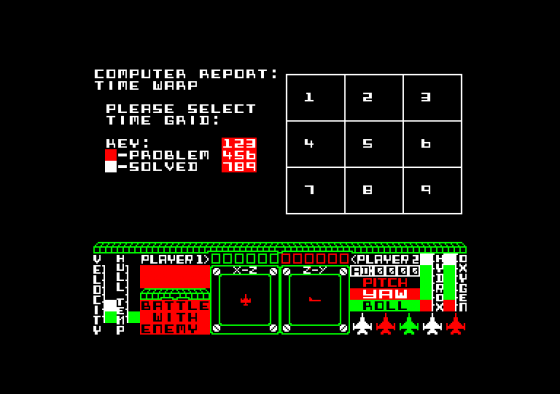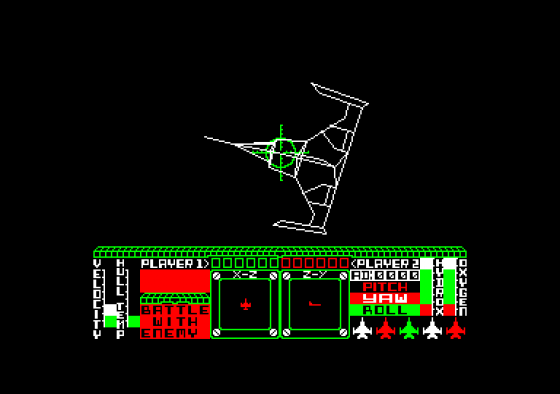
Amstrad Computer User
 1st November 1985
1st November 1985
Categories: Review: Software
Publisher: Melbourne House
Machine: Amstrad CPC464
Published in Amstrad Computer User #12
Starion
There have been several games that have included some form of 3-D graphics with varying degrees of success. In general, wire frame 3-D is usually preserved for the realms of outer space and so it is with Starion. 'Big deal' I hear you cry, '....so what's so good about this one?' Well, in terms of speed and smoothness there is nothing that comes anywhere near Starion. Complex enemy craft tumble and roll before your very eyes as if there were not thousands of complicated sums being processed for each frame. An this maths is fitted into only a small fraction of the time between frame flybacks so that there is still time to get the information onto the screen without any flicker at all - this is truly amazing and even the original designer of the Amstrad was seen to gasp in awe.
Pretty graphics aren't of course everything, they should merely serve to enlighten a good game plan. Thankfully, this is also the case in Starion. The cassette inlay waffles on about time being muddled and how one has to move the correct things to the correct time zones in order to put everything straight. In play, a time zone is picked and then battle commences.
You pilot your ship through the stars zapping a large number of different enemy craft. As each one is hit, you have time to swing round and see the debris elegantly reform into a letter of the alphabet. Your task is then to fly into this so that it may be sucked into your cargo hold. Depending on the time zone picked, there are a different number of letters needed to fill the hold. Having shot enough craft and collected a full complement of letters, you are then invited to fly to a teleport, which you must in fly to the middle of in order to be taken back to a screen where one can unravel the anagram of letters that have been collected (an easy example is ECE which is obviously (?) EEC). Having unravelled the anagram, one must then pick the time zone for which you think the word applies (EEC is 1957, the year in which the Treaty of Rome was produced (I have to admit that for most of the clues I used a crib sheet that was published in another mag' some time ago - but then I've only got the mentality of a games reviewer).

Having entered the new time zone, one must first fly to a planet at which point you find out if you have picked the correct time zone, and if not, you get to see the clue for that zone (which may be of use later) and then have the opportunity to battle on to get another chance to pick the correct zone. If the answer was correct, then you can start shooting ships and collecting letters for another word.
Not only has David Webb managed to cram an enormous amount of 3D wire frame info' into this game, there are also a huge number of clues and anagrams to give even the keenest brain a run for its money. At the start, you are given the opportunity to pick the number of players and game controls (though the process is a bit tedious). You can also pick tuition which has the ultimate in scrolly messages - in 3-D.
Better still for hackers, the text is held in ASCII and can be changed to your own personalised version. In flight, the controls are very responsive (almost too much so) and a panel at the bottom of the screen gives a host of useful information. Obviously, the number of remaining ships, along with the current state of the current one, are shown. The speed and temperature of the hull is also shown and it is important not to let it overheat. In the centre, two radar screens are shown, one for the X-Y direction (for which the enemy blob should be kept directly above the small ship in the middle) and the second is Y-Z which, is in effect, a measure of the range (the blob should be kept to the right and slightly above the ship in the centre).
It's not often I'm amazed by a new program for the Amstrad machines (the first time was probably for Sorcery when it first appeared, and the second time was for the two Ultimate games), but I am truly amazed by Starion. Just to update the screen at the rate they are managing to do so without flicker is pretty good, but to do 3-D calculations in the same time is just incredible. Add to this the fact that the game in which these graphics are used is also pretty good means that this is bound to be a sure fire winner.
Other Reviews Of Starion For The Amstrad CPC464
Starion (Melbourne House)
A review by D.M. (Home Computing Weekly)
Starion (Melbourne House)
A review
Starion (Melbourne House)
A review





